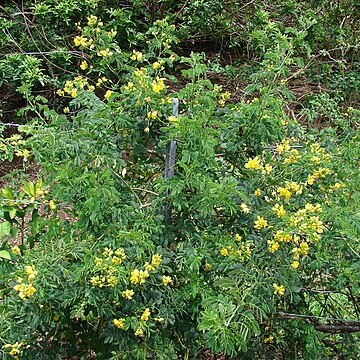Scandent or sprawling shrub to 4 m tall, the branches often arching. Leaves 6-12(-15) cm long, the petiole 1.5-3 cm long, the rachis bearing a squat, fusiform nectary between the proximal and sometimes all pairs of leaflets; leaflets 3-5 pairs, obovate to elliptic, the terminal pair 2-5 cm long x 1-2 cm wide, apex rounded to obtuse, base rounded, asymmetrical, venation often raised-reticulate. Inflorescences of axillary corymbose racemes, terminal on the branches and exserted above the foliage, peduncles stout, 4-6(-10) cm long at anthesis, pedicels 1-3 cm long, flowers 5-15 per raceme; sepals oblong to obovate, glabrous, unequal; petals obovate, 1-2 cm long, glabrous; fertile stamens 6, the lowermost abaxial stamen sterile and shorter than the 2 long abaxial stamens, anthers constricted below the apex, dehiscent by 2 confluent terminal pores, the apices of the abaxial anthers truncate, of the median anthers oblique; ovary glabrous to hirsute, stigma minutely porate. Fruits stipitate, cylindrical, inflated, linear-oblong, 5-10 cm long x 0.8-1.4 cm in diameter; valves glabrous, papery, dark brown, corrugated over the seeds, internally septate and pulpy; seeds in 2 rows, ovate, dark brown, glossy, lacking an areole.
An evergreen shrub. It grows 1-4 m above sea level. The leaves are alternate and compound. There are 3-6 pairs of leaflets. They are oblong. The flowering shoots have 3-12 flowers. They are near the tips of the stems. The flowers are yellow or yellowish-green. The fruit is a cylinder shaped pod. It is slender, smooth and dark green. It is 7-12 cm long.


